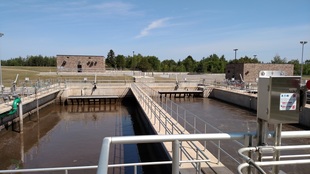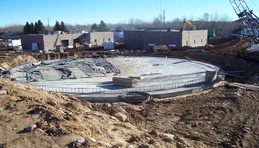|
|
December 2015

Strategic planning and investing in wastewater
infrastructure is helping a sanitary sewer district in northern Minnesota go
above and beyond for water quality. By pooling their resources, the four
communities in the Central Iron Range Sanitary Sewer District (CIRSSD) have
managed to afford the high capital costs of constructing, operating, and
maintaining a new wastewater treatment facility (photo at right) that meets
environmental standards and reaps several other benefits.
The district is based in Chisholm and also serves Buhl and Kinney
with Great Scott Township in the works.
This partnership is a great example of how working together
can benefit communities and water resources. A typical household generates 160
to 250 gallons of wastewater per day with additional volumes from industries.
In Minnesota, about 75% of that wastewater goes to a municipally owned sanitary
sewer collection system for treatment and then release into the environment,
usually by discharge to a lake or stream.
The Minnesota Pollution Control Agency (MPCA) works to
support communities in treating wastewater to ensure Minnesota’s waterways
support aquatic ecosystems, healthy communities, and a strong economy. These
are also the goals of CIRSSD which discharges treated wastewater to the St.
Louis River and Lake Superior downstream.
Before combining to one facility serving a broader area, the
Central Iron Range was previously serviced by two wastewater treatment
facilities in Chisholm and Buhl-Kinney.
|
 )
Phase 1 of the project included construction of sanitary
sewer and lift stations as well as replacement and rehabilitation projects to
the existing collection system, including lift stations. (Photo at right is
construction of the project.)
Phase 2 included building preliminary, primary and secondary
treatment and disinfection systems with the new facility starting operation in
spring 2014.
Phase 3 will include construction of advanced treatment
systems that are expected to be online by February 2017.
In addition, CIRSSD staff are identifying and eliminating
sources of inflow and infiltration (I & I) within each service community’s
collection system. For example, Chisholm is planning for a significant
collection system rehab project to occur in 2016 while the Buhl and Kinney
collection systems are being evaluated for sources of I & I.
The CIRSSD is reaping many benefits from regional planning
and investment:
- Economies of scale during
construction
- Better treatment performance
- Increased environmental
protection
- Lower operating and
administrative costs
- Affordable sewer rates
- Leverages funding
availability
- Greater consistency for
meeting water standards
- Enhances quality of life for
citizens
- Supports new economic development
The district leveraged funding from a number of sources,
including:
- 2005 Minnesota Bonding Bill – $1.7 million design grant
- Minnesota Public Facilities Authority – $12 million construction grant, an
$8.1 million low-interest loan plus about $4.8 million for I & I removal
projects
- Iron Range Resources and Rehabilitation Board Funds – $5.5 million
construction grants
Funding and planning are critical to keeping Minnesota’s waters swimmable,
fishable and drinkable. A 2014 MPCA
Wastewater Infrastructure Needs Survey identified more than 1,500
infrastructure improvement projects across the state that would cost nearly $4
billion dollars during the next 20 years.
For more information on financing, see the Wastewater
and stormwater financial assistance on the MPCA website.
For
more information on comprehensive sanitary sewer
maintenance programs:
|

Joel
Peck, the new municipal liaison with the MPCA (in photo at right), looks forward to meeting
with representatives
of local government units. He will work statewide, visiting with
municipalities about their concerns with wastewater permits and
operations.
“Any message they would like me to carry back to the agency, I’m there to represent interests
of local units of government,” Peck said.
He
brings a great deal of experience and expertise to the MPCA, having
worked for city governments,
the Minnesota House of Representatives, and the Minnesota League of
Cities. Peck most recently served as the city administrator for St.
Croix Falls, Wis., from 2011-2015 and as city administrator for Crosby,
Minn., from 2008-2011.
As a former city administrator, Peck has experience in infrastructure projects from the design
phase to construction, including the financing and political aspects.
“I look forward to connecting with municipalities and bringing back their messages,” he said.
You can reach Peck at 651-757-2202 or joel.peck@state.mn.us.
This new position was funded by the 2015 Minnesota Legislature.
|

Wild rice is an annual plant that grows in lakes, streams,
rivers and wetlands across Minnesota. It is an important resource because of
its economic, cultural, and ecosystem benefits.
In 1973 Minnesota adopted a 10 mg/L sulfate water quality standard to
protect wild rice. MPCA received funding from the Minnesota Legislature in 2011
for a study to better understand the effects of sulfate on wild rice and to
inform an evaluation of the current sulfate standard. Researchers at the
University of Minnesota under contract with the MPCA completed the study in
December 2013.
After reviewing study findings and additional data analysis,
MPCA has decided to propose a change to the current sulfate standard to better
reflect the interaction of sulfate and the environment where wild rice grows.
MPCA is in the process of developing the new proposal for sulfate to protect
for wild rice in Minnesota. This process, which includes various opportunities
for public input, proposes a new equation-based standard as an alternative to
the current statewide 10 mg/L standard. The equation would take into account
the specific sediment chemistry conditions, like the amount of iron or organic
matter, to determine a protective sulfate concentration for a given wild rice
water.
As part of the new proposed standard, MPCA will also compile
a draft list of waters to be included in rule as wild rice waters where the
standard will apply. More information on this can be found on the MPCA’s
sulfate and wild rice webpage.
You may be wondering, “What does all of this mean to me and
my city’s wastewater treatment operation?” Unfortunately, there’s not a quick
answer at this point. Ultimately, some wastewater treatment facilities will
have no change to their permits while others may be required to do the
following:
- Conduct sulfate effluent monitoring;
- Reduce sulfate in their wastewater treatment process where
practicable and feasible; and/or
- Eventually receive a water-quality-based effluent limit
(WQBEL) for sulfate.
MPCA will need to complete the rulemaking for the new
sulfate standard by January 2018 and collect more water and sediment
information across the state before any potential new sulfate WQBELs would be
placed in a permit. In the meantime, some facilities may be required to start
or continue monitoring sulfate in their effluent upon a future permit issuance.
Stay tuned for updates in future On Point newsletters. For
additional information, please refer to the MPCA’s sulfate
and wild rice webpage or contact Pat Engelking at Pat.Engelking@state.mn.us. If interested
in receiving updates on the rulemaking process via GovDelivery, sign up here.
Photo above: MPCA
staff harvest wild rice seeds from Little Round Lake in Becker County for
growth experiments on the effect of sulfate on wild rice.
|
Agency appreciates
patience during transition to new e-Services
|
Thanks
for your continued patience during the new online e-Services transition. Here
are a couple tips for submitting your DMR data.
If you have questions about the eDMR process,
please contact your assigned MPCA Compliance Staff person. You can
identify that person by visiting this webpage.
|
|
 |
|
|
|